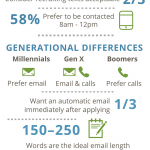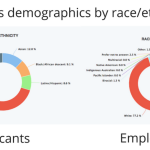Want To Attract The Right Job Candidates? Repel The Wrong Ones
To keep their edge in an intensely competitive hiring climate, some companies are trying to make themselves more attractive employers. In many ways, that’s understandable. Building an employer brand can create the sizzle that brings as many candidates as possible through your door. This is a mistake.
There’s no doubt that attracting talent is important. If you can’t do it, positions will remain unfilled, and the top people in your field will go to your competitor. But attracting the right talent is what really matters. Most companies already agree with this in principle, but many still overlook the fact that the goal of recruiting isn’t more candidates—it’s more of the right candidates. And their recruiting practices are still geared more toward the former than the latter.
Effective employer branding both attracts and repels. Do it right, and you may actually have fewer candidates applying to open positions, not more. But they’ll be making more informed decisions about your organization, so they’ll be likelier to go through the full interview process and ultimately accept an offer. In this case, less really is more.
Clogging The Recruiting Engine
A traditional recruiting funnel has a narrower top—you rope in applicants through job boards, recruiting agencies, and the like. Employer branding tries to widen it by adding more vehicles for influencing would-be candidates’ awareness and sentiments toward your company. Because most employer branding efforts are designed to influence positive sentiment, this means your entire recruiting funnel gets much bigger.
And that puts pressure on your recruiting team. It clogs the system with candidates that may not have opted in if they knew more about the work environment, warts and all. These candidates will likely connect the dots as they go through the interview process and withdraw (bad), or they’ll connect them after they’ve joined and then leave (terrible).
Those are bad enough, but over time, the strain of dealing with undesirable job applicants—and the risk of making bad hires as a result—can damage the very reputation you worked so hard to build in order to attract them in the first place. Candidates can leave feeling misled, and they’ll happily share their bad experience with their peers—which can lose you talent and customers in one fell swoop.
The goal instead should be to appeal to more informed candidates. Accurately convey the culture, job responsibilities, and growth paths you can offer new hires. Share the work styles that are the most effective in your organization. This increased awareness creates a narrower yet better entry to your hiring funnel. Potential candidates who don’t connect with those things can opt out before applying.
Be Uncomfortably Honest
There’s no utopian employer out there with a culture that’s perfect for everyone. We all have different drivers and motivators when it comes to our work—what we like to do and how we like to do it. One person’s dream job is another’s nightmare.
Amazon is a great example. In 2015, the New York Times published a controversial article on the tech giant’s work culture, detailing grueling hours and an intense work environment. Amazon took sharp issue with that characterization, but not only did its communications chief offer a counterpoint on Medium, the company’s employees took to LinkedIn to share their own views to explain how they thrived in a sometimes high-pressure environment.
While Amazon felt the Times story was unfair, the company didn’t pretend it was a laid-back, low-key workplace, either. The company launched a pilot program in September offering certain teams 30-hour workweeks and more flexible schedules, but Amazon was careful not to frame that as any kind of amends making. Embracing a work environment some might consider undesirable was brilliant employer branding.
In other words, Amazon knows perfectly well that Amazon isn’t right for everyone, but that the right person can thrive there. Candidates who don’t want that culture for themselves can opt out, while those who do can opt in.
Creating Sticky Hires
Embracing and sharing who you are as an employer and what you provide employees is key to creating “sticky hires”—people who take the offers you make. If you’ve been forthcoming in your employer branding and recruiting process, by the time you reach the offer stage, your acceptance rates should be stellar.
Why? You’ve already talked openly about things like compensation, career path, company growth and ambitions, internal conflicts, work-life balance, and so on. There are no surprises. A candidate is making their decision with eyes wide open.
The details and information you share with this approach are likely all things a new employee will soon learn on the job. If you’ve sold them something that doesn’t exist—or artfully buried that little internal conflict that’s going to make it tough for them to succeed in the role—they’re going to leave, and you’re going to have to recruit all over again. You’re creating a vicious cycle that will cause your recruiting engine to break down and your reputation to suffer.
Be open and honest. Let the best candidates for you find you, and let the others seek jobs elsewhere—you won’t be missing out.
Lars Schmidt is the founder of Amplify Talent, a recruiting and branding agency that helps companies like Hootsuite, NPR, and SpaceX reimagine the intersection of culture, talent, and brand. He’s also the cofounder of the HR Open Source initiative. Connect with Lars on Twitter at @Lars
Fast Company , Read Full Story
(35)














